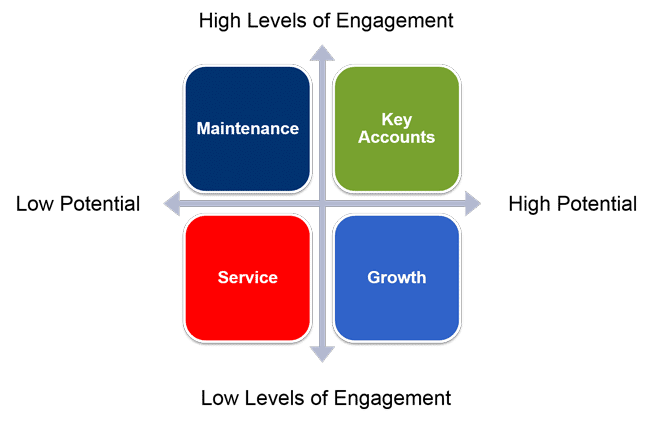Up selling and cross selling are profitable selling tactics. In fact, leveraging your current pool of clients is one of the best ways to increase your sales. I call this looking for incremental sales opportunities (ISO) But, to make these strategies effective, you need to be able to identify which clients you should approach.
The Sales Leader Classification System will help you identify which of your clients you should target with these tactics. The system helps you use levels of engagement and potential to group your clients into one of four categories: Maintenance, Key, Service or Growth Potential Accounts.
As discussed in an earlier post, you can also use this system to measure client growth. When you measure growth, take the time to reassess each account’s classification and change it if necessary. This process will help you discover which clients to approach with up and cross selling tactics.
For example, Key Accounts and Growth Potential Accounts are both characterized as having high potential for ISOs. Knowing this, you can focus your sales efforts on clients in these categories.
On the other hand, Maintenance and Service Accounts don’t have much room for growth, so looking for ISOs won’t be effective.
When you correctly classify your accounts, spend time measuring their growth, and understand how to use their classifications to your advantage, you can decide which ones to approach with sales pitches in a fraction of the time and with comparably little effort.
Growing Your Accounts
Keep in mind that it’s likely that some of your accounts will grow, shifting into a new classification. In fact, that is what you want. If you can bring some of your clients from the Service Accounts category to the Growth Potential category, you will have even more opportunities for increased sales.
How do you help your accounts grow? You increase your engagement, value and time to success.
Increase Engagement
First, proactively increase the level of engagement you have with your clients. Find more ways you can be involved with the accounts, more ways you can help the client and more ways you can sell your business.
To do this, you will need to build corporate rapport – that is a relationship with many contacts inside the account – and foster a relationship of trust with your client. Create an organization chart that can help you better understand where you need to focus time and who inside the company you have not met. Think of corporate report as infiltration. When you are heavily infiltrated with the client you are an insider. Insiders are exposed to more ISOs.
Next, sit down with your client for a business review meeting or a peer-to-peer conversation where you discuss your successes, failures, goals and how you can work together more effectively.
Increase Value from Vendor to Solution to Advisor
As you become more valuable to your clients, they will become more lucrative for your business. You may start out working with a client as a vendor, but if you can change that relationship to that of a solution and then finally to an advisor, you will gain new opportunities and increase your revenue.
How do you do this? The best way to increase the value you deliver by changing your relationship through high quality communication. Use benchmarks, trends, site visits, case studies and testimonials to prove how valuable you and your products are to your clients.
Speed up the Time to Success
Your job is not done when you have closed a sale and gained a new client. You need to continue to sell yourself and your organization to your current clients. How do you do this? Stay engaged and involved with your client, making sure they start using the product quickly. This strategy ensures value is received quickly which will encourage the client to grow.
Speeding up the time to success involves staying in touch with the client, ensuing they are enabled as quickly as possible and use the full breadth of your solution. Until they are using everything they purchased fully, the ISOs remain low.
The best sellers, those who create perpetual sales growth know that closing only ends when the client is fully enabled. As such they have redefined the closing stage in their pipelines from simply meaning “contract is signed” to “the client is participating in our solutions fully.” When you make this transition not only do you close more clients but you keep them longer and they become more profitable.




